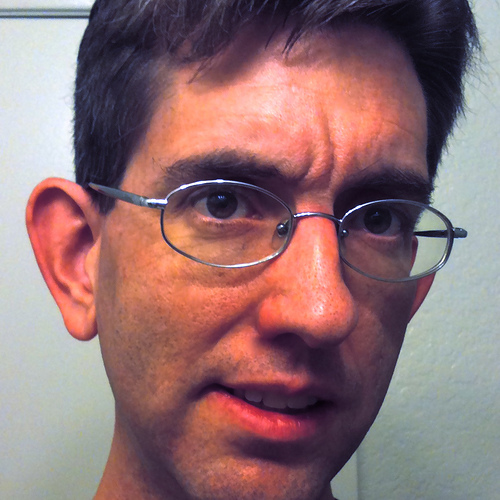Ken Hayworth, a cognitive neuroscientist, has the difficult task of juggling two hats on his head, or should we say brain.

With the first one, he and his colleagues at Harvard University are working on enhancing the power of an instrument which automates the mapping of brain tissues to answer a fundamental question that still faces neuroscience: How are the 100 billion neurons wired in the brain and how do they know what function to perform?
If you think that’s difficult to digest, ponder on the bigger objective that Hayworth has on his mind – not as a Harvard post-doctoral student but as president of ‘The Brain Preservation Foundation’: “My personal long-term goal is to upload a human mind into a machine. I think it’s the larger conclusion of neuroscience. This means I can put a specific mind into a robot.”
At Harvard, Hayworth and Jeff Lichtman (project head) have developed the Automatic Tape-Collecting Lathe Ultramicrotome (ATLUM) to allow efficient nano-scale imaging of large brain tissue volumes.
A microtome is an instrument that allows material to be cut into thin slices or sections for later staining and imaging in a scanning electron microscope (SEM). The ATLUM (now just ‘ATUM’) will ultimately enable neuroscientists understand the brain’s function by mapping the basic neuronal circuits.
“Neuroscientists want to map the brain to find out how the 100 billion neurons are wired up and how they produce function. The first generation instrument was a tape-collection mechanism that I built and which cost me $200,000 and was very difficult to use. I have now taken the tape-collection (crucial part) technology and shrunk it down into a version called the ATUM (no ‘L’),” explains Hayworth.
This new version costs just $10,000 to build and hooks on to a commercial ultramicrotome and gives laboratories the ability to collect thousands of ultra-thin sections and then use standard electron microscopes to do very large-scale mapping “because we can cut a cubic mm tissue in a week, though some reliability issues remain”.
Hayworth’s liking for the brain started when he was in high school. “I was extremely interested in space travel and wanted to go to the nearest star. I got books to find out how to make a starship to travel to the nearest star, but was very disappointed to realize that it was virtually impossible to do that (it will take around 50,000 years to travel with today’s technology and the human biological form is not suitable for such travel). It was around that time that I picked up a book on ‘neural networks’ and it hit me that if we can extract the matter from our bodies as information, we will be able to transmit it at the speed of light to the nearest star akin to a large radio transmitter which can beam the brain. That’s the genesis of my interest in neuroscience,” he explains.
But is uploading the mind into a robot or an exoskeleton possible? “Most people think that the brain is inscrutable but so far, that hypothesis is wrong,” asserts Hayworth.
In the next five years, he is confident of seeing an entire human brain preserved chemically and embedded in plastic. This brain, he explains, can eventually be automatically cut into ultrathin strips and scanned at very fast rates and high-resolutions. With these maps, neuroscientists can figure out how the neurons are wired and how they create memories, skills and personalities.
“With advancements in technology, you will have enough information to reconstruct the information process that is going on inside the brain and you will be able to understand where the memories, skills, and the overall function are stored. You can then put all that into a computer, and hook it to a robotic body and flip the switch on. Because it’s a direct copy of the individual human brain, that simulation of that brain will be conscious, have the same memories, same skills, personality etc. – from a materialistic point, it will be the same person,” says Hayworth.
The original person will be quite dead but you can create as many copies of that person with this simulation, he adds.
Hayworth, however, has not been able to sell his idea effectively. Many neuroscientists do not agree that a mind can live outside a biological body. They believe that the mind is too complex to understand. Even those that grudgingly believe that the mind can be uploaded are not sure if it will be the same person. “They don’t believe that a mechanical simulation of the brain would not be conscious, and even if yes, it won’t be the same person,” rues Hayworth.
Hayworth, on his part, argues that the uploaded mind would be the same person “and I believe that my argument rests on what is standard in neuroscience textbooks – that consciousness is a function of the information processing that’s going on in the brain”.
“If this uploaded copy of you has the same memories, same skills, same personality, then you have to agree that it’s the same individual and this is a method of preserving someone’s life,” he asserts.
But Hayworth is convinced that once the scientific and medical community understands that brain preservation techniques (cryonics or plastination) are successful in preserving “high-quality brains”, people will come around the idea eventually. He admits, though, that legal problems will remain (currently, one can’t preserve a brain before a person is legally dead).
Regardless, he is awarding a prize of $106,000 for anyone who can preserve a large mammalian brain such that all the synaptic connections are intact using today’s technology.
Two major laboratories are competing for the prize, says Hayworth, adding: “We have to image that brain and verify that claim ourselves, for which we will need the help of labs and more money. Currently, I have zero money in the bank.”
But he is optimistic that “This message will resonate. I have been talking to some very wealthy people (who do not want to disclose their identities currently). They believe in this and want to see credibility. Once people start seeing results in brain preservation, there will be more converts.”
“Today we are expendable creatures of evolution. Science tells us that we are here to propagate DNA molecules onto the next generation. I see that as a prison that we are born into by the fact that we are biological beings. But we have consciousness, emotions and feelings. This technology will give us the ability to break out of that prison and not have to grow old, be subject to disease, depression, etc.,” says Hayworth.
He gives the analogy of a computer wherein you buy a new hard drive for your old data. “An uploaded mind will not age and could be vastly more intelligent. An uploaded mind in a robot can explore a well of happiness that we are locked away in our biological confines,” philosophises Hayworth.
“Do we care about our genes or wiring programme? We care about our soul – and science tells us that the soul is a collection of our memories, personality traits and skills, all of which are coded in the neural circuitry. That’s what we really are and that’s the thing that brain preservation and mind uploading will succeed in doing,” he concludes.
